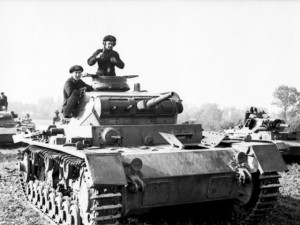The development of the tank reached new heights during the Second World War, and it was in Germany in particular where a lot of the most rapid development would take place. This had not always been the case, however, as Germany had been relatively late in joining the development race. Although the Germans had successfully matched British achievements with regard to the manufacturing of such vehicles during the latter stages of the First World War, further development in Germany would be stifled by the restrictions placed on Germany by the Treaty of Versailles, but also due to the grandiose ambitions of a number of designers and manufacturers.
Breaking the restrictions
During the mid-1920s, however, many German manufacturers had found ways to get around the restrictions, seeking help from a number of countries including Sweden, Switzerland, Denmark, and – perhaps more ironically – the Soviet Union. Given access to the special facility located at Kazan east of the Urals, the Germans were able to carry out the rapid development of what was to be the new generation of armoured fighting vehicles.
The first of the series of armoured vehicle with the prefix Pz. Kpfw. (Panzerkampfwagen – Armoured Fighting Vehicle) – was be the Panzer I, designed by the Krupp concern. All vehicle types were also given a unique Sd. Kfz. (Sonderkraftfahrzeug – Special Purpose Vehicle) designation, with the Pz. Kpfw. I being classified as the Sd. Kfz. 101. The Pz. Kpfw. I was a lightly-armed two-man vehicle which would see action during the Spanish Civil War and the early German campaigns in Poland, the Low Countries and France, although by the time of the Polish campaign their function had by and large been relegated to that of a support role.
The success of the Pz. Kpfw. I was to see the development of the Pz. Kpfw. II (Sd. Kfz 121), which soon gave way to the benchmark Pz. Kpfw. III (Sd. Kfz. 141) designed by Daimler-Benz in 1937. The 21-tonne Pz. Kpfw. III was a well built and highly reliable vehicle, and was highly effective during the early stages of the war. Its chassis would provide the basis for a number of highly successful variants, notably the turretless Sturmgeschütz (StuG) III assault gun – which was used to devastating effect by Michael Wittmann during his first tour of duty in Russia.

Design improvements
The Pz. Kpfw. III was soon succeeded by the Krupp-Rheinmetall Pz. Kpfw. IV (Sd. Kfz 161), which like its predecessor was to prove itself on the battlefield, with many examples remaining in service right until the end of the war.
At this time, however – with the threat of war seeming inevitable – there was a growing feeling among many experts that a tank with superior armament and protection was required. A number of German designers instantly showed an interest in the idea of producing a heavy tank; one company assigned the task of carrying out the relevant feasibility studies was the Kassel-based firm of Henschel und Söhne, although a number of submissions from other manufacturers, such as Daimler-Benz, MAN and Porsche, were also submitted.
By October 1941, the prototype Henschel VK 3001, a 30-tonne vehicle armed with a 75mm KwK (Kampfwagenkanone) main gun, rolled off the production lines, but this was soon shelved in late 1941 when, after the capture of a Soviet T34/76, the need arose for a heavier vehicle – with a weight in the region of 45 tonnes – which was to offer a greater level of protection and firepower.
The idea for the design of the Pz. Kpfw. VI Tiger was born.
Ironically, the 30-tonne design was later revived and resulted in the production of the Pz. Kpfw. V Panther (Sd. Kfz 171) whose variants were to see a high level of success during the latter stages of the war.
